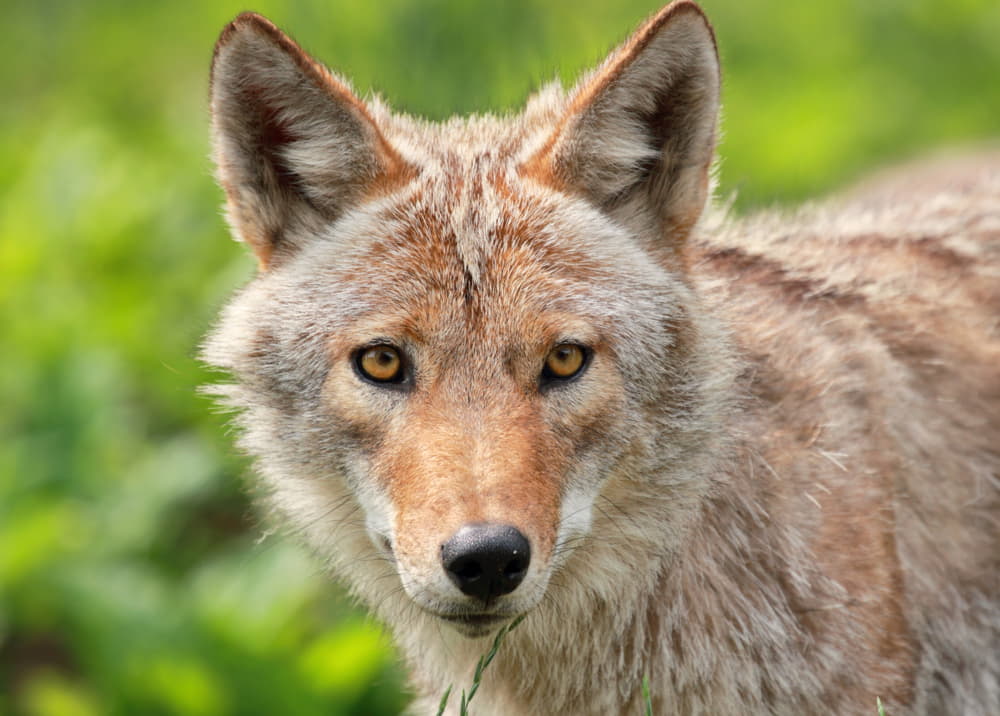When you started thinking about hunting coyotes at night I bet you wondered which type of light you needed. What color light can coyotes not see is a question that hunters need to understand to make the most accurate choice for their hunt.
Coyotes have evolved with unique visual capabilities that enable them to thrive in their natural habitats. While they have great night vision and can see a wide variety of colors, there is one section of the light spectrum that they cannot see.
But how do we know which colors of light coyotes cannot see? Scientists do know what to check for when determining color blindness in animals. Thereby, we know coyotes are colorblind to particular colors.
Coyotes perceive different colors than humans because their eyes are constructed differently than ours. This article provides you with proven knowledge about vision as well as the color light that coyotes cannot see.
Table of Contents
Understanding Coyote Vision
Coyotes have rather strong visual acuity, or the capacity to distinguish minute details. Understanding the intricacies of coyotes’ vision can help hunters decide on the best color light for their next hunt.
Night Vision
Coyotes are most active during the twilight hours of dawn and dusk, as well as at night. Their eyes are equipped with a high density of rod cells, which are extremely sensitive to low levels of light. This adaptation allows them to see well in conditions where most animals would struggle.
Tapetum Lucidum
Behind coyotes retinas have a reflecting layer called the tapetum lucidum. This layer bounces light back into the retina, providing photoreceptor cells a second opportunity to perceive it. This phenomenon enhances their night vision, causing their eyes to appear to glow when illuminated in the dark.
Color Vision
Coyotes only have two cone cells in their eyes, making them dichromats. They can perceive with their highest sensitivity in the blue and yellow parts of the spectrum. They have somewhat less color vision than humans because they have fewer color receptors in their retinas.
Motion Detection
Coyotes are good at detecting movement. The coyote’s eyes consist of more rod cells, which are photoreceptor cells that can sense dim light and movement. They can detect predators and other potential threats thanks to this adaptability, even in low light.
What Color Light Can Coyotes Not See?
Coyotes cannot see colors with long wavelengths of light such as red or orange. This limitation arises from the composition of their retinas and the types of photoreceptor cells they possess.

They have two main types of photoreceptor cells in their retinas: rods and cones. Rod cells are highly sensitive to low levels of light and are primarily responsible for night vision. They are crucial for detecting motion and shapes in low-light conditions. However, rod cells are not specialized for detecting colors.
Cones cells are responsible for color vision. Coyotes only have two cone cells: blue and yellow. This enables them to see colors in the yellow and blue spectrums. It limits their color perception and provides them with only dichromatic vision.
In other words, they are colorblind to certain hues, particularly those with long wavelengths like red. Red has the longest wavelength in the visible spectrum and requires its own cone cells to be detected. Therefore, the answer to the question “Can coyotes see red light?” is no. Instead, red hues likely appear as varying shades of gray or brown to them.
Can coyotes see green light? No, coyotes also cannot see green light in the same manner as people. Coyotes can detect green light to some extent but it appears less bright to them than other colors. This is because green light falls within the spectrum of colors that coyotes have difficulty perceiving.
The Best Color Lights For Coyote Hunting
The best color light for coyote hunting is red. They have a hard time seeing green as well, but red is better. Because red has a longer wavelength and provides a “buffer” from the cutoff of what wavelength light coyotes’ eyes can see. Utilizing red coyote hunting lights in your arsenal is a great idea to enhance the success rate of your hunting excursion.
Infrared light is another option you can consider. Infrared lights are not visible to the human eye but can be seen with night vision equipment. Using infrared lights combined with night vision devices is highly effective in secretly hunting wolves.
Read this post: What Time Do Coyotes Come Out At Night?
5 Features Every Coyote Hunting Light Should Have
Here are 5 essential features to look for in a coyote hunting light:
- Adjust brightness: Ensure the light should offer adjustable brightness settings to allow you to adapt to different hunting conditions. Lower brightness for scanning and navigating, while higher brightness is useful for spotting and identifying targets.
- Zoom or Focus Control: Ensure lights feature zoom or focus control, which allows you to adjust the beam’s width and reach.This is especially helpful for detecting coyotes from a distance.
- Long Battery Life: Ensure lights have a long-lasting battery or the option to use rechargeable batteries. Carry extra batteries with you to guarantee you don’t run out of power during your quest. Battery life is crucial, especially for extended hunts.
- Durability: Ensure the light is built with features like water resistance, shock resistance, and a durable housing. Because coyote hunting often involves rough terrain and harsh weather conditions.
- Lightweight and Compact: Ensure the light has a lightweight and compact design. This makes it easier to carry and maneuver, especially on long trips.
Final Thoughts
In summary, coyotes cannot see colors with long wavelengths of light like red. They only have two cone cells: blue and yellow. While coyotes may have difficulty seeing certain colors of light, they have other adaptations that allow them to flourish in their settings. By understanding what colors coyotes can’t see, we can design better lighting strategies and make smarter decisions while hunting.

